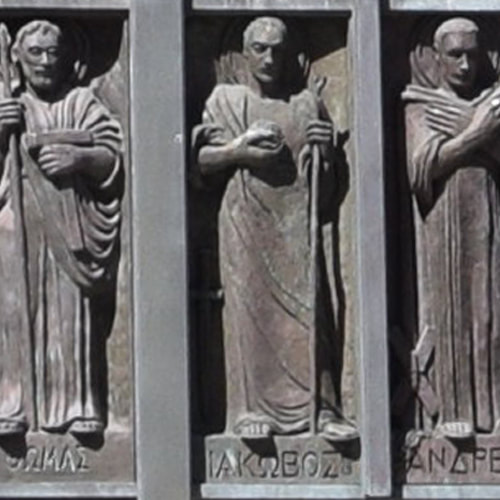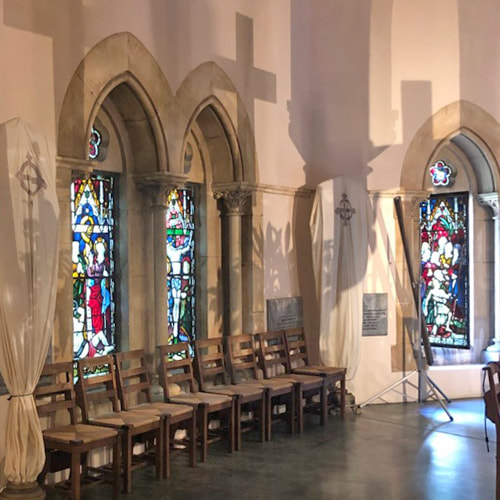"Always present in the church are kāhili, royal standards made of feathers atop a long pole, like those used by the kings and queens of Hawai‘i. The kahili are red and yellow, as are the pulls on the peal of bells in the tower, because these are the colors of Hawaiian royalty." E. Beasley, The Living Church, May 6, 2001
Caring for Our Kāhili

Our Cathedral proudly displays three pairs of kāhili. Those are the feathered standards that signify we are in the presence of Ali‘i. On Tuesday, October 6th, Mele Chun, the third generation kumu hulu (feather masters) to create and care for our Cathedral Kāhili came to do maintenance projects on two pairs of our kāhili.
In the Wahi Kapu (chapel in honor of our Holy Sovereigns), there are a pair of kāhili lima pa‘a (hand held size) that flank the icon of Kamehameha IV and Queen Emma. They have had red ribbons at the end of the feather quills (see photo on left), which always looked tacky in comparison with the radiance of the icon. Mele had rolls of jute (natural fibers) and we chose one that closely resembled the weaving in the Marques Marzan wall hanging. She wrapped the ends of the feather quills to bind them in a natural, streamlined manner.
Flanking the high altar are the Sesquicentennial kahili we made in 2011-12. The elastic in the velvet skirt of the kāhili on the Diamond Head side had worn out and broken letting the skirt droop. Mele climbed a step ladder and sewed new elastic into that skirt to hold it into place (see her doing this in the photo at the top).
Casey Santoianni, our Sexton, has cleverly inserted security locks to hold the poles of the Sesquicentennial kahili and the 1972 kāhili onto their stands, thereby foiling possible vandals.
The last of our three pairs of kāhili still need maintenance. We made plans on how to refurbish our third pair: the 1972 kahili standing alongside the lectern and pulpit (see photo on the left). While the poles and the stands are fine, everything else (Styrofoam cylinders and all featherwork) must be rebuilt. For this major project, they will need to be moved to Mele Chun’s shop: Na Lima Mili No‘eau on Kapahulu for that work. We hope to start that within the next six months.
— Ann Dugdale Hansen, Chair, Nohona Hawaiʻi
In the Wahi Kapu (chapel in honor of our Holy Sovereigns), there are a pair of kāhili lima pa‘a (hand held size) that flank the icon of Kamehameha IV and Queen Emma. They have had red ribbons at the end of the feather quills (see photo on left), which always looked tacky in comparison with the radiance of the icon. Mele had rolls of jute (natural fibers) and we chose one that closely resembled the weaving in the Marques Marzan wall hanging. She wrapped the ends of the feather quills to bind them in a natural, streamlined manner.
Flanking the high altar are the Sesquicentennial kahili we made in 2011-12. The elastic in the velvet skirt of the kāhili on the Diamond Head side had worn out and broken letting the skirt droop. Mele climbed a step ladder and sewed new elastic into that skirt to hold it into place (see her doing this in the photo at the top).
Casey Santoianni, our Sexton, has cleverly inserted security locks to hold the poles of the Sesquicentennial kahili and the 1972 kāhili onto their stands, thereby foiling possible vandals.
The last of our three pairs of kāhili still need maintenance. We made plans on how to refurbish our third pair: the 1972 kahili standing alongside the lectern and pulpit (see photo on the left). While the poles and the stands are fine, everything else (Styrofoam cylinders and all featherwork) must be rebuilt. For this major project, they will need to be moved to Mele Chun’s shop: Na Lima Mili No‘eau on Kapahulu for that work. We hope to start that within the next six months.
— Ann Dugdale Hansen, Chair, Nohona Hawaiʻi

















